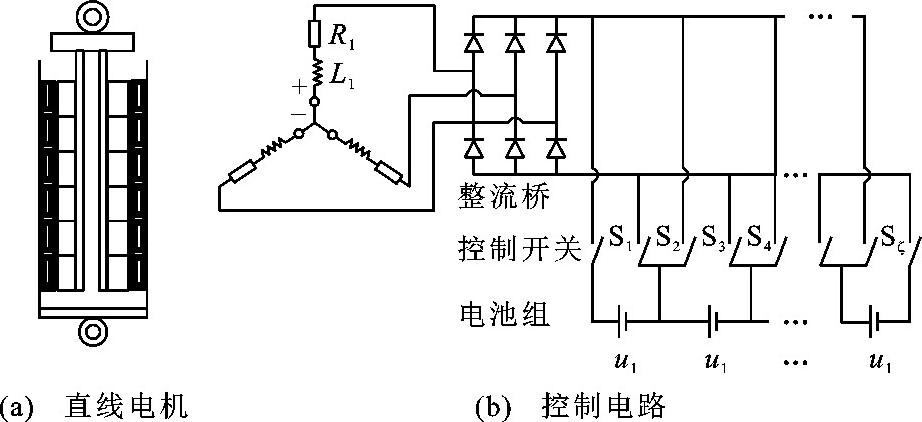Control of energy-reclaiming semi-active suspension with linear motor based on varying charge voltage method
-
摘要: 针对以直线电机作为执行器的馈能型半主动悬架控制方法复杂与效果差等问题, 结合变压充电控制原理与方法, 提出一种利用单相等效模型求解充电电压的方法, 设计了馈能型半主动悬架控制系统, 用于控制直线电机式馈能执行器; 建立了1/2车4自由度动力学模型和变压充电控制直线电机模型, 采用LQG控制策略求解理想馈能阻尼力; 将联接有整流桥的直线电机理论模型等效为单相电机模型, 计算了电机单相等效模型反电动势、电磁推力系数、电阻与电感参数; 采用充电电压求解控制器, 以悬架相对速度和理想馈能阻尼力作为输入求解实际充电电压, 进而实现执行器馈能控制; 以被动悬架和理想半主动悬架作为比较对象, 分析了馈能型半主动悬架性能与馈能效果。分析结果表明: 与被动悬架相比, 馈能型半主动悬架与理想半主动悬架的综合性能指标分别减小38.97%和45.42%, 前后悬架实际馈能阻尼力与理想馈能阻尼力的相关系数分别为0.967 4和0.976 8, 并且前后悬架振动能量的56.7%和62.1%被回收进蓄电池中, 因此, 采用基于单相等效模型与变压充电方法控制的馈能型半主动悬架能够回收大部分悬架振动能量和改善汽车的行驶平顺性。Abstract: To solve the difficult problems in the control of energy-reclaiming semi-active suspension (ERSAS) with linear motor as the actuator, such as complex control method and unsatisfactory control effect, a calculating method of charge voltage based on a single phase equivalent model was proposed by combining with the principle and method of varying charge voltage (VCV).The control system of ERSAS was designed to regulate the energy-reclaiming actuator with linear motor.The half vehicle dynamics model with 4 degrees of freedom and the VCV linear motor model were set up, and the LQG control strategy was used to obtain the ideal energy-reclaiming damping forces.The theoretical model with bridge rectifier was equivalent toasingle phase motor model, and the back electromotive force, electromagnetic thrust coefficient, resistance and inductance of single phase motor model were calculated.The controller was solved by using the actual charge voltage, the relative speeds of front and rear suspensions and the ideal energy-reclaiming damping forces were taken as the inputs to calculate the actual charge voltage, and the energy-reclaiming control was realized by using the actuator. The suspension performances and energy-reclaiming effects were analyzed by comparing the ERSAS with the passive suspension and the ideal semi-active suspension.Analysis result shows that, compared with the passive suspension, the comprehensive performance indexes of ERSAS and ideal semiactive suspension reduce by 38.97% and 45.42%, respectively, the correlation coefficients between the actual and ideal energy-reclaiming damping forces of front and rear suspensions reach to 0.967 4 and 0.976 8, respectively, and 56.7% and 62.1% of vibration energies in the front and rear suspensions are reclaimed and stored in the battery, respectively.In summary, adopting ERSAS based on the VCV method and the single-phase equivalent model can recover most of vibration energy and improve vehicle ride performance.
-
表 1 电机仿真主要参数
Table 1. Main parameters in motor simulation

表 2 电磁推力拟合精度
Table 2. Fitting precision of electromagnetic thrust

表 3 仿真参数
Table 3. Simulation parameters

表 4 理想与实际馈能阻尼力相关性
Table 4. Correlation between ideal and actual energy-reclaiming damping forces

表 5 悬架性能指标对比
Table 5. Comparison of performance indexes of suspensions

表 6 馈能型半主动悬架的能量回收数据
Table 6. Energy recovery data of ERSAS

-
[1] THOMPSON A G. An active suspension with optimal linear state feedback[J]. Vehicle System Dynamics, 1976, 5 (4): 187-203. doi: 10.1080/00423117608968414 [2] 喻凡, 张勇超. 馈能型车辆主动悬架技术[J]. 农业机械学报, 2010, 41 (1): 1-6. doi: 10.3969/j.issn.1000-1298.2010.01.001YU Fan, ZHANG Chao-yong. Technology of regenerative vehicle active suspension[J]. Transactions of the Chinese Society of Agricultural Machinery, 2010, 41 (1): 1-6. (in Chinese). doi: 10.3969/j.issn.1000-1298.2010.01.001 [3] FIALHO I, BALAS G J. Road adaptive active suspension design using linear parameter-varying gain-scheduling[J]. IEEE Transactions on Control Systems Technology, 2002, 10 (1): 43-54. doi: 10.1109/87.974337 [4] 姚嘉伶, 蔡伟义, 陈宁. 汽车半主动悬架系统发展状况[J]. 汽车工程, 2006, 28 (3): 276-280. doi: 10.3321/j.issn:1000-680X.2006.03.015YAO Jia-ling, CAI Wei-yi, CHEN Ning. A review on the development status of automotive semi-active suspension systems[J]. Automotive Engineering, 2006, 28 (3): 276-280. (in Chinese). doi: 10.3321/j.issn:1000-680X.2006.03.015 [5] 郭全民, 雷蓓蓓. 半主动悬架PID控制的研究和优化[J]. 国外电子测量技术, 2015, 34 (4): 60-63. doi: 10.3969/j.issn.1002-8978.2015.04.014GUO Quan-min, LEI Bei-bei. Research and optimization for semi-active suspension PID control[J]. Foreign Electronic Measurement Technology, 2015, 34 (4): 60-63. (in Chinese). doi: 10.3969/j.issn.1002-8978.2015.04.014 [6] IELUZZI M, TURCO P, MONTIGLIO M. Development of a heavy truck semi-active suspension control[J]. Control Engineering Practice, 2006, 14 (3): 305-312. doi: 10.1016/j.conengprac.2005.03.019 [7] YOKOYAMA M, HEDRUCK J K, TOYAMA S. A model following sliding mode controller for semi-active suspension systems with MR dampers[C]∥IEEE. Proceedings of the2001American Control Conference. New York: IEEE, 2001: 2652-2657. [8] POUSSOT-VASSAL C, SAVARESI S M, SPELTA C, et al. A methodology for optimal semi-active suspension systems performance evaluation[C]∥IEEE. 49th IEEE Conference on Decision and Control. New York: IEEE, 2010: 2892-2897. [9] SHI De-hua, CHEN Long, WANG Ruo-chen, et al. Design and experiment study of a semi-active energy-regenerative suspension system[J]. Smart Materials and Structures, 2015, 24 (1): 15001-1-12. doi: 10.1088/0964-1726/24/1/015001 [10] OKADA Y, KIM S S, OZAWA K. Energy regenerative and active control suspension[C]∥ASME. ASME 2003International Design Engineering Technical Conferences and Computers and Information in Engineering Conference. New York: ASME, 2003: 2135-2142. [11] BRANDENBURG G, BRUCKL S, DORMANN J, et al. Comparative investigation of rotary and linear motor feed drive systems for high precision machine tools[C]∥IEEE. Proceedings of 6th International Workshop on International Workshop on Advanced Motion Control. New York: IEEE, 2000: 384-389. [12] 张进秋, 岳杰, 彭志召, 等. 车辆电磁悬挂系统技术综述[J]. 拖拉机与农用运输车, 2014, 41 (3): 4-12. https://www.cnki.com.cn/Article/CJFDTOTAL-TLJY201403002.htmZHANG Jin-qiu, YUE Jie, PENG Zhi-zhao, et al. Review of electromagnetic suspension technology for vehicle[J]. Tractor and Farm Transporter, 2014, 41 (3): 4-12. (in Chinese). https://www.cnki.com.cn/Article/CJFDTOTAL-TLJY201403002.htm [13] GOLDNER R B, ZERIGIAN P. Electromagnetic linear generator and shock absorber: USA, US6952060B2[P]. 2005-04. [14] 陈宏伟. 车辆节能型主动悬架的研究[D]. 西安: 西安理工大学, 2008.CHEN Hong-wei. The research on active suspension of saving energy[D]. Xi‘an: Xi’an University of Technology, 2008. (in Chinese). [15] 来飞. 基于电磁作动器的车辆主动悬架研究[D]. 重庆: 重庆大学, 2010.LAI Fei. Investigation of vehicle active suspension based upon electromagnetic actuator[D]. Chongqing: Chongqing University, 2010. (in Chinese). [16] GYSEN B L J, VAN DER SANDE T P J, PAULIDES J J H, et al. Efficiency of a regenerative direct-drive electromagnetic active suspension[J]. IEEE Transactions on Vehicular Technology, 2011, 60 (4): 1384-1393. doi: 10.1109/TVT.2011.2131160 [17] GYSEN B L J, JANSSEN J L G, PAULIDES J J H, et al. Design aspects of an active electromagnetic suspension system for automotive applications[J]. IEEE Transactions on Industry Applications, 2009, 45 (5): 1589-1597. doi: 10.1109/TIA.2009.2027097 [18] 陈龙, 汪佳佳, 汪若尘, 等. 基于能量优化的混合馈能悬架阻尼优化设计[J]. 农业机械学报, 2016, 47 (8): 305-310, 316. https://www.cnki.com.cn/Article/CJFDTOTAL-NYJX201608040.htmCHEN-Long, WANG Jia-jia, WANG Ruo-chen, et al. Damping optimization design of hybrid energy regenerative suspension system based on energy optimization[J]. Transactions of the Chinese Society for Agricultural Machinery, 2016, 47 (8): 305-310, 316. (in Chinese). https://www.cnki.com.cn/Article/CJFDTOTAL-NYJX201608040.htm [19] STRIBRSKY A, HYNIOVA K, HONCU J, et al. Energy recuperation in automotive active suspension systems with linear electric motor[C]∥IEEE. Proceedings of the 15th Mediterranean Conference on Control and Automation. New York: IEEE, 2007: 1-5. [20] 赵成, 胡增荣, 陈大跃. 半主动悬架的滑模变结构控制[J]. 中国公路学报, 2007, 20 (3): 109-114. https://www.cnki.com.cn/Article/CJFDTOTAL-ZGGL200703019.htmZHAO Cheng, HU Zeng-rong, CHEN Da-yue. Sliding mode varing structure control for semi-active suspension[J]. China Journal of Highway and Transport, 2007, 20 (3): 109-114. (in Chinese). https://www.cnki.com.cn/Article/CJFDTOTAL-ZGGL200703019.htm [21] 罗虹, 陈星, 邓兆祥, 等. 主动悬架的直线电机作动器控制系统研究[J]. 系统仿真学报, 2012, 24 (7): 1537-1542. https://www.cnki.com.cn/Article/CJFDTOTAL-XTFZ201207034.htmLUO Hong, CHEN Xing, DENG Zhao-xiang, et al. Research on control system of linear motor actuator used in active suspension[J]. Journal of System Simulation, 2012, 24 (7): 1537-1542. (in Chinese). https://www.cnki.com.cn/Article/CJFDTOTAL-XTFZ201207034.htm [22] 陈星, 罗虹, 邓兆祥. 直线电机馈能悬架控制系统设计与馈能分析[J]. 振动与冲击, 2012, 31 (8): 124-129. doi: 10.3969/j.issn.1000-3835.2012.08.025CHEN Xing, LUO Hong, DENG Zhao-xiang. Design of an energy-regenerative suspension control system using linear motor and energy recovery analysis[J]. Journal of Vibration and Shock, 2012, 31 (8): 124-129. (in Chinese). doi: 10.3969/j.issn.1000-3835.2012.08.025 [23] 黄大山, 张进秋, 刘义乐, 等. 车辆馈能悬挂系统滑模控制及能量管理策略研究[J]. 兵工学报, 2016, 37 (12): 2185-2195. doi: 10.3969/j.issn.1000-1093.2016.12.002HUANG Da-shan, ZHANG Jin-qiu, LIU Yi-le, et al. Research on sliding mode control and energy management strategy of energy-regenerative suspension system of vehicle[J]. Acta Armamentarii, 2016, 37 (12): 2185-2195. (in Chinese). doi: 10.3969/j.issn.1000-1093.2016.12.002 [24] 厉萱. 基于蓄电池充电电压可变的电磁馈能型半主动悬架控制研究[D]. 镇江: 江苏大学, 2013.LI Xuan. Research on control of electromagnetic semi-active suspension reclaiming energy based on method varying battery charge voltage[D]. Zhenjiang: Jiangsu University, 2013. (in Chinese). [25] 张勇超. 车辆电磁主动悬架鲁棒控制研究[D]. 上海: 上海交通大学, 2012.ZHANG Yong-chao. Study on robust control for vehicle active electromagnetic suspension[D]. Shanghai: Shanghai Jiaotong University, 2012. (in Chinese). [26] 黄昆, 喻凡, 张勇超. 电磁式主动悬架模型预测控制器设计[J]. 上海交通大学学报, 2010, 44 (11): 1619-1624. https://www.cnki.com.cn/Article/CJFDTOTAL-SHJT201011028.htmHUANG Kun, YU Fan, ZHANG Yong-chao. Model predictive controller design for electromagnetic active suspension[J]. Journal of Shanghai Jiaotong University, 2010, 44 (11): 1619-1624. (in Chinese). https://www.cnki.com.cn/Article/CJFDTOTAL-SHJT201011028.htm [27] 兰利亚. 电流型逆变电源控制方法的研究[D]. 天津: 天津工业大学, 2017.LAN Li-ya. Research on control method of current type inverter power supply[D]. Tianjin: Tianjin University of Technology, 2017. (in Chinese). [28] WANG J B, JEWELL G W, HOWE D. A general framework for the analysis and design of tubular linear permanent magnet machines[J]. IEEE Transactions on Magnetics, 1999, 35 (3): 1986-2000. [29] 张海涛, 高洪, 查为民, 等. 具有LQG控制器的主动悬架半车模型动力学分析与仿真[J]. 安徽工程大学学报, 2012, 27 (1): 42-45. https://www.cnki.com.cn/Article/CJFDTOTAL-AHJD201201013.htmZHANG Hai-tao, GAO Hong, ZHA Wei-min, et al. Dynamics simulation and analysis of a half vehicle model’s active suspension with LQG controller[J]. Journal of Anhui Polytechnic University, 2012, 27 (1): 42-45. (in Chinese). https://www.cnki.com.cn/Article/CJFDTOTAL-AHJD201201013.htm [30] 陈士安, 邱峰, 何仁, 等. 一种确定车辆悬架LQG控制加权系数的方法[J]. 振动与冲击, 2008, 27 (2): 65-68, 176. https://www.cnki.com.cn/Article/CJFDTOTAL-ZDCJ200802013.htmCHEN Shi-an, QIU Feng, HE Ren, et al. A method for choosing weights in a suspension LQG control[J]. Journal of Vibration and Shock, 2008, 27 (2): 65-68, 176. (in Chinese). https://www.cnki.com.cn/Article/CJFDTOTAL-ZDCJ200802013.htm [31] 郑玲, 邓兆祥, 李以农. 汽车半主动悬架的模型参考自适应控制[J]. 中国公路学报, 2005, 18 (2): 99-102. https://www.cnki.com.cn/Article/CJFDTOTAL-ZGGL20050200J.htmZHENG Ling, DENG Zhao-xiang, LI Yi-nong. Model reference adaptive control of semi-active suspensions[J]. China Journal of Highway and Transport, 2005, 18 (2): 99-102. (in Chinese). https://www.cnki.com.cn/Article/CJFDTOTAL-ZGGL20050200J.htm [32] 陈士安, 王骏骋, 姚明. 车辆半主动悬架全息最优滑模控制器设计方法[J]. 交通运输工程学报, 2016, 16 (3): 72-83, 99. http://transport.chd.edu.cn/article/id/201603009CHEN Shi-an, WANG Jun-cheng, YAO Ming. Design method of holographic optimal sliding mode controller for semi-active suspension of vehicle[J]. Journal of Traffic and Transportation Engineering, 2016, 16 (3): 72-83, 99. (in Chinese). http://transport.chd.edu.cn/article/id/201603009 -





 下载:
下载:






















